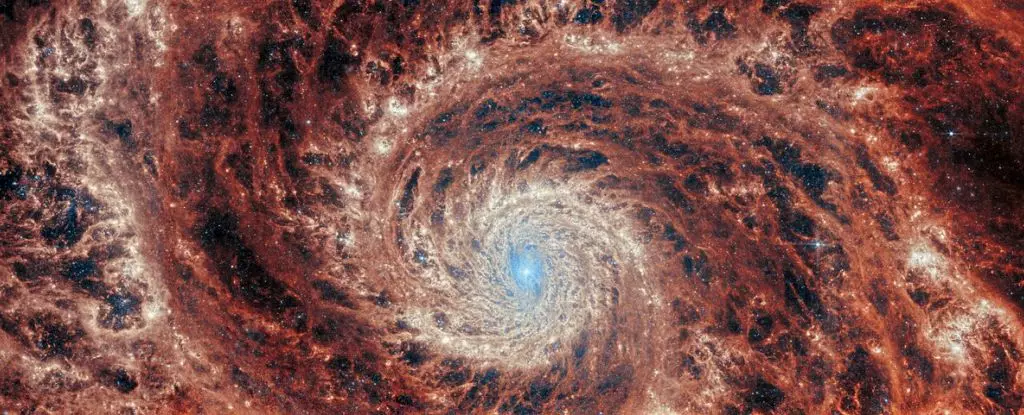The cosmos is an ever-evolving tapestry, woven with threads of fantastical formations and intricate structures that have unfolded since the dawn of time. The recent identification of a massive galaxy, Zhúlóng, by the James Webb Space Telescope (JWST) has stirred the scientific community by challenging long-held preconceptions regarding the formation timeline of galaxies in the early universe. This discovery, dating back to an astonishing 12.8 billion years ago, propels our understanding of cosmic evolution in ways that deserve a deeper exploration.
The period known as the Cosmic Dawn represents an important chapter in the history of our universe, occurring within the first billion years following the Big Bang. During this era, primordial matter began to coalesce into galaxies, setting the stage for the stellar nurseries and cosmic structures that followed. Traditionally, scientists believed that galaxy formation was a slow and gradual process, with intricate structures, particularly spiral formations, emerging only later in this timeline. However, the discovery of Zhúlóng has elicited questions about the validity of these chronological assumptions.
Zhúlóng, named after the mythical Torch Dragon from Chinese folklore, exemplifies a different narrative. Rather than being a rudimentary formation, this galaxy possesses a remarkably defined structure reminiscent of grand design spiral galaxies, characterized by prominent and well-formed arms that spring from a luminous galactic nucleus. Such structural definition and maturity at this early stage in the universe’s life suggest a level of complexity beyond what many astrophysicists had previously anticipated.
Structural Integrity of Zhúlóng
Emerging from the JWST’s PANORAMIC survey, Zhúlóng stands out not merely for its size—measuring approximately 62,000 light-years in diameter—but also for its morphological sophistication. Researchers, led by astronomer Mengyuan Xiao from the University of Geneva, have argued that its features embody characteristics found in some of the more advanced spirals observed today, such as the Milky Way.
Zhúlóng is noted for its “quiescent-like classical bulge,” alongside a star-forming stellar disk and the impressive grand-design spiral arms that define its structure. This contrasts noteworthy with the expectations that such spiral structures would only materialize in more mature galaxies billions of years later. Observations suggest that Zhúlóng’s formation rate, with estimates ranging from 20 to 155 solar masses a year, indicates a deceleration in star formation, suggesting an evolutionary transition toward a more stable existence.
The significance of Zhúlóng transcends its immediate structural marvel. Its discovery compels a reassessment of galaxy formation models, particularly concerning the assembly timeline of massive galaxies and the advent of spiral configurations. According to the research team, Zhúlóng may represent a monumental case, demonstrating that Milky Way-like galaxies can coalesce far more rapidly than previously understood—ten times faster, to be precise—than the formations witnessed today.
As scientists delve deeper into the implications of such findings, they must now consider the acceleration of galactic complexities in the early universe—a shift that opens the door for numerous avenues of investigation. What previously seemed like a gradual timeline for galaxy formation now appears to demand a more nuanced approach, incorporating the potential for rapid evolution driven by unseen factors.
Future Implications for Cosmic Research
Zhúlóng stands as a beacon for future astronomical inquiries, drawing attention to the need for advanced observational strategies to unravel the hidden narratives of the cosmos. With technology such as JWST at the forefront, researchers are equipped with the tools to probe deeper into the universe’s infancy, potentially unveiling more galaxies akin to Zhúlóng that defy pre-existing theories.
The implications of discovering such early-forming mature galaxies extend beyond just the structure; they challenge scientists to reconsider how early environmental conditions around massive black holes influenced galactic assembly. As the data unfolds, it is clear that Zhúlóng does not merely add another name to the catalog of galaxies—it fundamentally reshapes our understanding of cosmological development during one of the universe’s most crucial epochs.
As we expand our understanding of the universe, discoveries like Zhúlóng push the boundaries of astrophysics and reveal the profound complexities of cosmic evolution that still await our exploration.


Leave a Reply